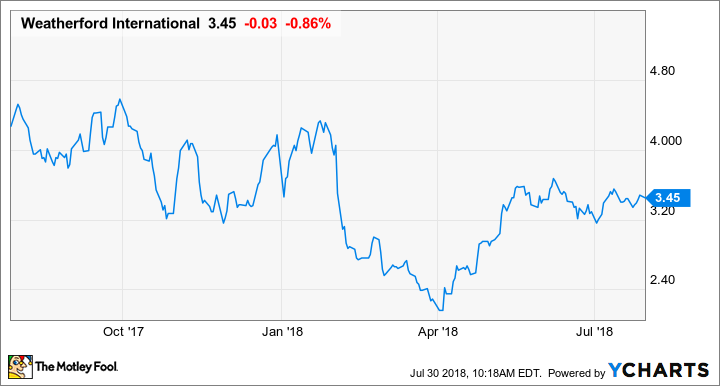For about a year, Weatherford International (NYSE: WFT)'s new CEO Mark McCollum has been at the helm, and he's promised to turn the fledgling oil services company around into a profitable endeavor. Although the market for oil services has been challenging over the past year, progress on Weatherford's turnaround plan has been agonizingly slow. While its peers posted strong revenue growth numbers and surging profitability, this company's earnings continue to stall out.
Let's take a look at why this is the case, and whether Weatherford is on the right path or not.

Image source: Getty Images.
By the numbers
| Metric | Q2 2018 | Q1 2018 | Q2 2017 |
|---|---|---|---|
| Revenue | $1.45 billion | $1.42 billion | $1.36 billion |
| Operating income | ($75 million) | ($39 million) | ($145 million) |
| Net income | ($264 million) | ($245 million) | ($171 million) |
| Diluted EPS | ($0.26) | ($0.25) | ($0.17) |
DATA SOURCE: WEATHERFORD INTERNATIONAL EARNINGS RELEASE. EPS= EARNINGS PER SHARE.
It's really hard to get excited about 6% year-over-year revenue growth when larger peers Schlumberger (SLB -2.14%) and Halliburton are posting double-digit growth rates these days. Even more frustrating is the fact that services and equipment in North American shale drilling are incredibly tight, so service providers are commanding a decent premium. Yet looking at Weatherford's results, the strength of the North American market is nowhere to be found.
Much of the company's lackluster growth has to do with where it does business. Weatherford doesn't have much presence in North American shale after it sold its pressure-pumping business to Schlumberger earlier this year. Instead, it has a large presence in Canada, Latin America, and the Eastern Hemisphere. These markets have been slower to pick back up than U.S. shale, and Weatherford's bottom line has reflected that.

Data source: Weatherford international earnings release. Chart by author.
In prior quarters, management has said that it was going to sell off some assets to improve profitability and pay down portions of its rather onerous debt load. After the quarter closed but before releasing earnings, it announced a deal where it will sell a portion of its land rig fleet in the Middle East and North Africa for $287 million, as well exiting a joint venture for an undisclosed amount. Management said it is closing two additional deals that should net the company about $500 million.
What management had to say
From an investor's standpoint, this turnaround seems to be taking a long time. But McCollum's press-release statement seemed rather optimistic about the company's turnaround plan, and the progress he and his team have made on improving profitability:
Seasonal trends worked against us this quarter, causing us to miss our working capital objectives and, in turn, our cash flow target. The entire organization, however, remains intensely focused on delivering our objective of breakeven free cash flow for the year, and remedial actions have already been implemented to get us back on plan. With a clear mission, the right structure, and a solid strategy, our team is embracing this challenge head-on. We are continuing to drive significant change across all aspects of our business to better position Weatherford to create value for all of our stakeholders.
As part of his conference-call presentation, McCollum mentioned that there is a plan to remove $1 billion in structural costs that will immediately translate into better EBITDA (earnings before interest, taxes, depreciation, and amortization) results by the end of 2019. So far, he says that the company has achieved 19% of these savings.
Turnaround plan to what, exactly?
For anyone who's been a long-term investor in Weatherford (are there any out there anymore?), it feels as though this company has been in a perpetual state of turnaround for the past five years. Management has been promising a return to profitable operations and free cash flow for half a decade, but there hasn't been anything to show for it.
When McCollum laid out his plan a little over a year ago, he asked investors to have patience because it would take some time to sort out. A year on, though, it's hard to see any tangible results in the company's earnings statements. Perhaps Weatherford will be able to realize its goals for a profitable business by 2019, but it hardly seems worth the wait when there are other oil services companies with more attractive value propositions these days.




